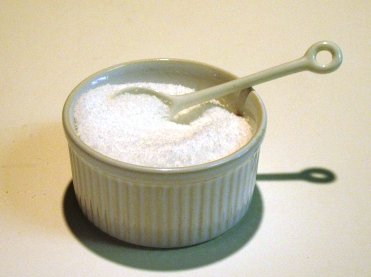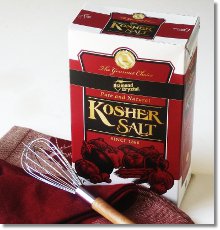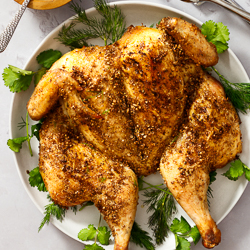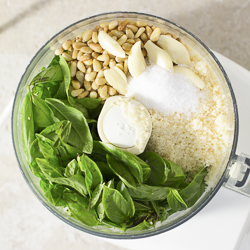In the last post, I talked about how I learned about salt, and made some recommendations for how you can experiment with seasoning in your own kitchen.
But then my Aunt Leah fired back an email. “Okay,” she said, “but tell me, what’s the big deal about kosher salt? Is it from a holy place? Does it have magic minerals? Is there is secret ceremony in the sprinkling? Why do you professional cooks keep a bowl of it handy next to the pepper grinder?”
All good questions. And ones you might also be wondering about. Along with olive oil, salt is the most common thing I get questions about in my cooking classes. I imagine that’s because both are ingredients we use most every day, and yet there seem to be more and more types of them at the store all the time. It can get overwhelming.
There’s kosher salt, British sea salt, French fleur de sel, Hawaiian red clay salt, roasted Korean salt, black salt, pink salt, coarse salt, fine salt, crystals, flakes, and gold Peruvian salt harvested during the full moon by pygmies! (Just kidding about that last one.)
So, what’s the ding-dang deal with all the salts?
The short answer is—salt is salt. No matter where it’s from or how much it costs, all salts are roughly 99% sodium chloride, your friend NaCl from high school chemistry. The rest is minerals, and in such trace amounts you’re not likely to taste the difference from one to another.
So when you’re using salt in a recipe where it’s going to dissolve—in a soup or a sauté, for example—there’s no point using anything fancy. Use whatever is inexpensive and whatever you’re used to.
Where you may notice a difference from one salt to another is in a raw application, as in a final sprinkling before you eat. Two things account for that difference, one being that 1% difference between salts, where one may have a little magnesium and another has iron or potassium.
The other, more likely thing that makes a difference between fancy salts, however, is texture. Depending on the construction of the salt crystals—fine, coarse, flaked, whatever—they will melt, or not, and land in different spots on your tongue, or not, effecting the way your food tastes.
In other words, when it’s going to get cooked in, use whatever salt you have on hand. When it’s going to be sprinkled on top, you might find that different salts make the same food taste different.
Which brings us to kosher salt. No, Aunt Leah, kosher salt isn’t from a holy place and doesn’t have magic minerals. In fact, it should really be called koshering salt because rather than being okay to use if you observe kosher dietary laws (all salt is dietarily kosher), kosher salt the salt that’s used to prepare meat in accordance with those laws.
Why is kosher salt so popular with chefs? One, because it’s pure. It doesn’t have things like calcium silicate, dextrose, and potassium iodide, which are added to many table salts and which some people say they can taste. (Calcium silicate can leave a metallic taste at the tip of your tongue.) And two, kosher salt’s larger crystals make it easier to grab and sprinkle with bare fingers as chefs are prone to do. And three, kosher salt is inexpensive. So it’s a pure, large-crystal salt that’s inexpensive. Those three things earn it a place in a professional kitchen.
But it’s worth mentioning that a lot of chefs use kosher salt simply because a lot of chefs use kosher salt. I mean, how uncool would I be if I didn’t? And that’s just as good a reason as any, I suppose.
Does this mean you have to use kosher salt? Depends if you want to be cool. But seriously, you should use absolutely whatever kind of salt you’re happy with. But note that, while salt is salt by weight, because of its large crystals, a coarse salt, like Diamond Crystal kosher salt, takes up more volume than in a measuring spoon than fine salt or even a less coarse kosher salt, like Morton’s. So if you want to substitute table salt, or any other fine salt, for Diamond Crystal, use about 50% less by volume than is called for.
And vice versa—if you want to use kosher salt in a recipe that calls for table salt (usually referred to as simply “salt” in an ingredient list), use about twice as much.
One caveat. In baking, use the type of salt that the recipe specifies. Besides adding flavor, salt plays chemical roles in baked goods that shouldn’t be messed with.
You’ve solved so many great mysteries for me, dear Auntie—are there any others I can solve for you?









